by Winding Pathways | May 6, 2021 | (Sub)Urban Homesteading, Flowers/Grasses, Garden/Yard
Springtime on the Prairie
This spring we anxiously await the emergence of prairie flowers in an area that had been traditional lawn. This is a periodic continuing blog about the process of converting the lawn to a prairie. We’ll have a couple more updates this season. Here’s what we did to prepare for this year’s growth:
2020
April and May 2020: Sustainable Landscape Solutions sprayed the lawn twice to kill existing grass plants, which were nearly entirely exotic species.
May 2020: Sustainable Landscape Solutions tilled the now dead turf.
May 2020: Rich and Marion broadcast a diverse array of seeds that included 82 wildflower species and a few lower-growing types of priaire grasses.
August 2020: A derecho felled three trees west of the site and a few to the east. This increases the sun on the new prairie. That’s good.
By mid-summer, a thick growth of annual crabgrass covered the site with only partridge pea obvious from our seeds.
November 2020: The crabgrass was dead and dry, so we burned it on the same day we burned our existing prairies. The fire was slow and low.
2021
Winter 2020/21: Heavy snow covered the site for much of the winter. When it melted, we discovered mostly bare soil with few surviving exotic grasses present. This is perfect, as native seeds will respond to warm temperatures.
April 2021: Small prairie forbs are emerging. Among the many spring greens poking up, we can identify Black-Eyed Susans, Mountain Mint, and Partridge Pea. Only a few of the 82 species we cast out. Part of the fun of restoring prairie is learning what the emerging plants are.
-
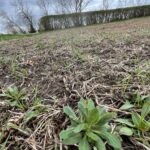
-
Part of the fun of establishing prairies is learning what the plants are.
-

-
Possibly shooting star?
-
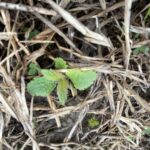
-
Poking through
We’ll update with a Prairie Renaissance Blog as the natives get going.
by Winding Pathways | Apr 22, 2021 | (Sub)Urban Homesteading, Garden/Yard, Mammals
Readers’ Adventures With Pogo Possum
The Pogo Possum adventures really resonated with people. So, Winding Pathways is sharing some of these.
SA enthusiastically wrote: I love that you named him Pogo. “We have met the enemy and he is us.”
JH has a thoughtful perspective: Pogo certainly has some caring humans. I agree with you that they are very interesting critters. I just wish the rest of the world that zips by in four-wheeled contraptions would think likewise instead of hitting them.
MH shared: We found one in our house. I was gone for a week. I like fresh air at night so left an outside door open that had a small hole in the screen my husband called to say there was a pile of poop in the living room. On investigation, he found one hidden behind our TV console. We guessed he came in through the screen.
From Colleges to Communities Pogo Resonates
MM told about Kirkwood Community College’s adventures: While at Kirkwood, when the original greenhouses were attached to my Grounds Department building, we found a female, with babies, living in the north greenhouse. Once Stacey, the students, and my crew understood the benefits of having this tenant, we left her and her babies alone. Occasionally, one of the babies would explore the greenhouse, but with a little coaxing, he or she would return to the nest. I was fortunate to see the mother finally take her young out of the greenhouse, exposing them to their new life outside of the greenhouse environment. I don’t know if it was the same opossum or one of the babies, but one of them must have been paying rent, as each year we welcomed a resident, with babies. I do miss the interaction and YES, I was providing a bit of food, as well as the occasional rat or mouse courtesy of the raptor building behind our greenhouses.
SR What a lovely story about Pogo, your cozy little possum neighbor! Friends not far from you have another small one who scoots on into the garage for cat food whenever the door is open. One day she found it curled up for a daytime nap inside the watering can in her garage. What a handy handle to walk it on back outside. The sleepy little creature just looked up blinking its eyes and smacking its possum smile. Then it ambled right out of the watering can once she put it down on its side. I dare anyone to try this with a raccoon or even a groundhog.
AF Too cute to pass up commenting on. We too have a possum neighbor.
PL succinctly wrote: Love Pogo!!!
Thank you, all for sharing your Pogo adventures! This looks like a periodic series on an ancient, maligned and interesting resident among us.
-
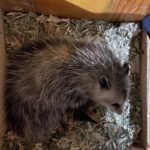
-
After eating an egg, Pogo took a nap.
-
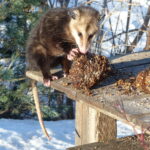
-
Possums have agile hands.
-
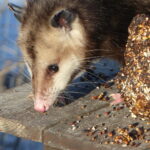
-
On a cold winter day Pogo appeared.
Thank you, all for sharing your Pogo adventures! This looks like a periodic series on an ancient, maligned, and interesting resident among us.
by Winding Pathways | Apr 1, 2021 | (Sub)Urban Homesteading, Garden/Yard, Garden/Yard, Nature
Winter Wanderers
We’ve been having more adventures with possums. Marion spotted a new visitor to the bird feeder one late February afternoon.
It was a smallish opossum. We called him “Pogo” after one of our favorite cartoon characters but didn’t realize we’d be playing tag with him (or her) for the next few weeks.
Pogo’s Feet
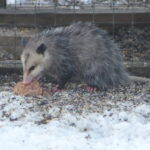
Possums’ feet help it hold food and climb.
Many people dislike possums and think they’re ugly and dumb. We like ‘em. They’re fascinating and love to eat ticks, including those that spread Lyme Disease. We find their paws especially interesting. Take a look at Pogo’s feet in the photos. They’re like strong-clawed hands that let him climb.
We spotted Pogo a few evenings later sniffing around our composter. He ambled off and scooted under a brush pile, where we assume he lived. That’s a fine place for an opossum to live so we left a scoop of dog food nearby for a late-night snack.
The next night Rich went out after dark to check the chickens in the barn. He turned on the light and there, staring at him from inside, was Pogo. Now, we like possums but not when they’re in the barn near the chickens.
Quite Comfortable

After eating an egg, Pogo took a nap.
I wondered, how in the world did he get in? We searched high and low for holes in the building big enough for a smallish opossum to squeeze through. There weren’t any, so we assumed he probably scooted in the open door during the day unseen. Rich ushered him out.
We didn’t see Pogo after that for a few days until Rich went out to gather eggs. There was Pogo napping in a nest! Our possum never seemed aggressive. He didn’t growl, snarl, or attempt to bite the shovel Rich used to scoot him out the door. He just opened his toothy mouth, stared at Rich as if to say, “What’s the problem?” and ambled to the brush pile. Again, we looked for possible openings and didn’t find any.
Quite at Home
No sign of Pogo for two more days. Then it was coop spring cleaning time. The chicken’s waterer was perched on two cinder blocks. Rich removed the waterer and went to pick up a cinder block when he saw a nose pointing out. There sat Pogo, curled up snugly inside one of the block’s cavities.
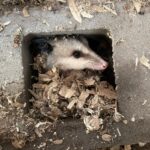
Opossum curled up in cinder block nest.
Again, all he did was stare and open his mouth as Rich explained that he was welcome to live under the brush pile but not in the barn.
We think we have the mystery solved. Pogo didn’t come into the barn after dark. He walked right through the chicken’s pop hole door when it was open during the day and made a home in the cinder block. It’s a great possum spot. He slept on soft wood chips and had plenty of fresh water and chicken feed nearby. Pogo probably snacked on an egg or two but never attempted to catch or kill a chicken.
We still want him to live in the brush pile but not in the barn. So, we now carefully monitor every nook and cranny in the barn before we lock the door at night. We haven’t seen Pogo in the coop lately and hope he’s relocated permanently to the brush pile.
by Winding Pathways | Mar 18, 2021 | (Sub)Urban Homesteading, Birds, Garden/Yard, Nature, Trees/Shrubs
March is a pivot month. It’s neither winter nor spring. Often called “mud season”, March is maple syruping time, but it’s also birdhouse building month at Winding Pathways.
As humans in northern climates wade through mud and long for spring, millions of birds far to the south are planning their long migration north. A few hardy waterfowl arrive as soon as the ice melts from lakes and ponds, but most birds appear, as if by magic, in April and May. We make sure our birdhouses are up before they arrive.
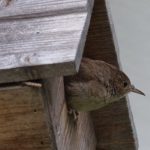
Looking out at the world.
House Wrens, Eastern Phoebes, American Robins, House Sparrows, and House Finches all nest on or near homes, barns, and garages. Although few people enjoy seeing messy House Sparrow nests tucked into nooks and crannies, most love hosting the native species as they raise the new generation outside the window.
Make Birdhouses
March is the best month to make birdhouses and restore older ones somewhat worse for the wear. Most are easy to build using simple carpentry tools. Better yet, birds aren’t fussy. Although the size of the house and the diameter of the entrance hole is important, the residents don’t care if the maker is an excellent carpenter or a novice. So, if the joints don’t fit perfectly it won’t bother birds!
Helping children make birdhouses is a fun project that involves them in nature as they learn safe tool use and basic construction techniques.
We scrounge a nearby pallet pile for free wood. Often the discarded pallets are made from boards the right width for our houses. Relatively inexpensive pine, spruce, or fir work for people who prefer to buy wood.
-
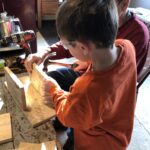
-
Working with children to make a birdhouse is rewarding.
-
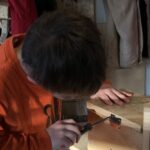
-
Children learn wood types, stages of building and how tools work.
-
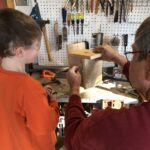
-
The birdhouse is nearly complete.
Great Resources to Guide Your Work
The best information source for virtually anything about wild birds is the Cornell University Laboratory of Ornithology. Their website gives great information on many aspects of birds, including what species likely live in an area. The site is complex but fascinating. A second website, also by the Lab, is more specific to birdhouses and nesting. The Laboratory of Ornithology site helps anyone predict what birds might migrate to their yard and when they’ll arrive. It also includes plans on how to build birdhouses. There’s even a video showing construction tips.
There’s more to birdhouses than just making one. They must be erected in the right place and height above the ground. The Lab’s website provides the right information. And, here are two tips from Winding Pathways.
Tips from Winding Pathways
- Many birdhouse plans to use nails as a hinge so the house can be opened for cleaning. We buy and use small hinges, hooks, and eyes to make opening the box to clean it easier.
- It’s tempting to attach a birdhouse to a tree using a nail or screw. That may work but eventually, the birdhouse falls off. But, the metal remains embedded in the tree. This creates danger as the tree grows around the metal, hiding it. Hitting a nail with a chainsaw is downright scary and dangerous. Also, driving a nail into a live tree can introduce diseases that could kill it. We use wire or rope to attach our birdhouses to live trees and use screws to attach birdhouses to nonliving posts and poles. One of our wren houses is suspended from a hook screwed into our porch ceiling.
Building birdhouses and enjoying a wren couple raises a brood is a fun family activity that we never tire of.
by Winding Pathways | Mar 4, 2021 | Garden/Yard, Mammals
Bright sun and warm breezes broke Iowa’s February subzero weather. Being outside unencumbered by thick gloves, boots, and coats felt great, and we even enjoyed a cup of coffee sitting outside on the sunny side of our home. We weren’t alone. A glance at the bird feeder one late afternoon revealed a friend we hadn’t seen in months. An opossum was enjoying a meal of seeds while basking in the relative warmth. We suspect the animal had spent frigid days and nights dormant under a brush pile.
Many people don’t like possums but we do. They’re fascinating – and helpful! The Iowa DNR lists these little-known facts about Iowa’s only marsupial, an animal that cares for its young in a pouch similar to the Australian kangaroo.
-
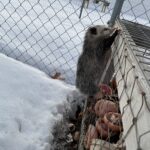
-
This young possum climbs up the compost bin to scavenge food.
-

-
In broad daylight this possum feasted on a block of seeds.
-

-
Possums have agile hands.
Fun Facts About Opossums
- Possums are virtually immune to rabies.
- A copperhead or rattlesnake might bite a possum and be surprised. These ancient animals are immune to their poison and will likely gobble up the hapless snake for lunch. Not so much in Iowa. Poisonous snakes are rare here and only found in a few areas.
- No other native mammal has as many teeth. Opossums have 50. When approached they’ll often open their mouth and show them off. They also might hiss, but our possums didn’t make any threatening moves.
- Possums play possum. It discourages some predators but doesn’t work with cars. Many are killed as they crossroads. Do avoid hitting them.
- Possums have hind feet that look a bit like a human hand. Their tracks in the snow are distinctive.
- Female opossums have 13 teats. Twelve are in a circle in her pouch with one in the center.
- Babies are tiny. The size of a dime. After birth, they finish developing in mom’s pouch. When they are older, they’ll often ride on her back.
- Some sources say opossums reduce tick numbers. They often groom themselves and consider any tick they find a tasty snack.
We enjoy seeing our opossum friends. On cold nights we sometimes put a little cat or dog food out for them. Life’s not easy for these animals with naked tails and thin fur, so we try to help them.
by Winding Pathways | Feb 25, 2021 | (Sub)Urban Homesteading, Garden/Yard, Garden/Yard, Nature
November 5, 2020, was a perfect day for burning our prairie. We’d enjoyed several days of dry weather, and had our fire permit. We just needed a bit of breeze.
On that gorgeous day we burned the labyrinth, the backyard prairie, and our savanna…….and then we struck a match into our newest prairie. With the help of Linn County Roads and Air Pollution Departments, Pheasants Forever, the Monarch Research Project, UNI, and Sustainable Landscape Solutions we had prepared the soil and killed the weeds last May. Then we broadcast a native seed mix containing 82 species.
Prairie’s slow to start. We didn’t expect much this first year and ended up with lots of crabgrass. It grew to about 8” and dried out nicely. A slow fire removed most of it, allowing sunshine to warm prairie plants beneath. We expect a resurgence of delightful plants next spring and summer.
-

-
We burned the new prairie to encourage the native plants.
-

-
Several organizations and businesses are collaborating to create and manage the prairie.
















